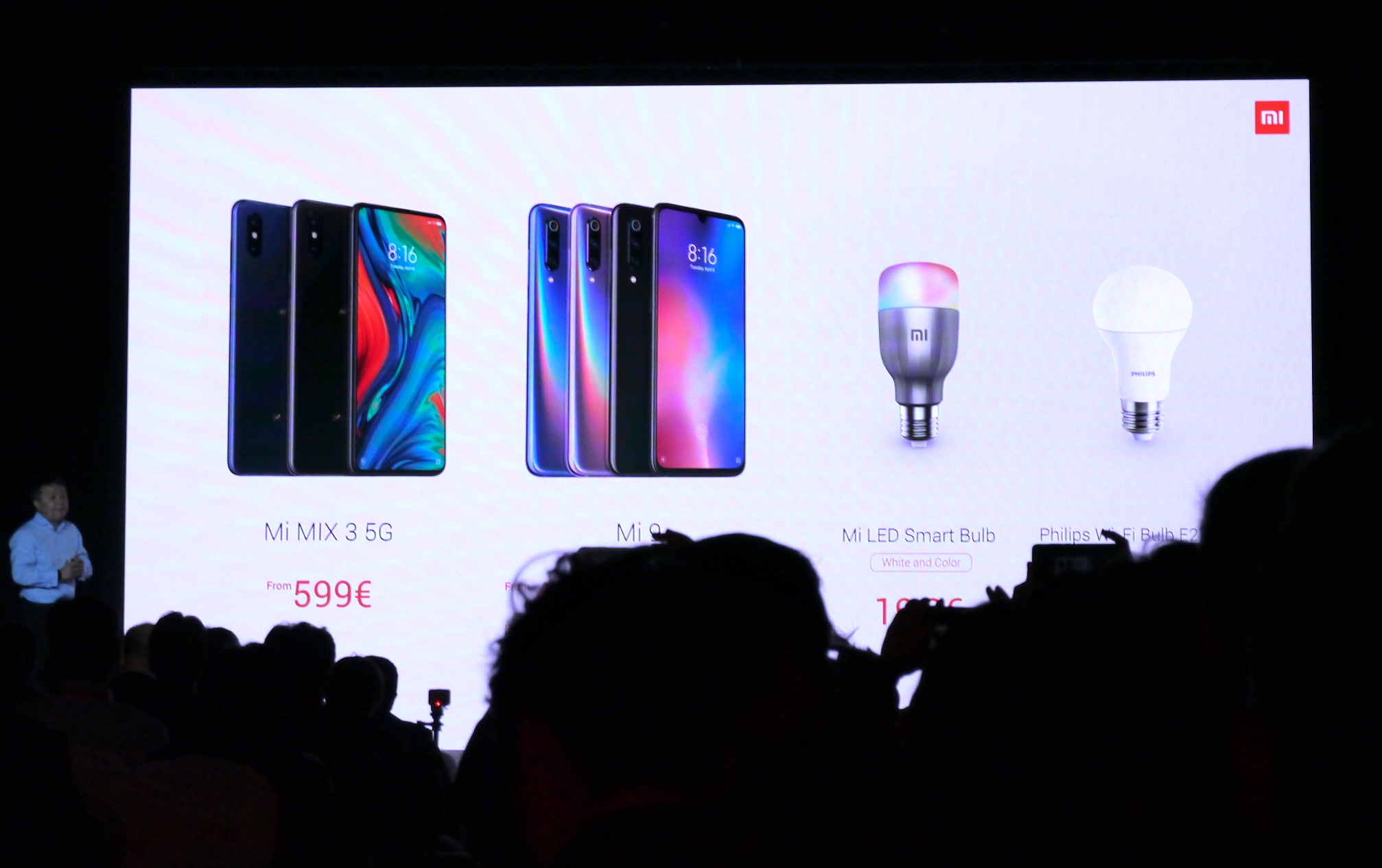Come comment on this article: [TA Deals] Save 97% on the Ultimate Microsoft SQL Certification bundle
[TA Deals] Save 97% on the Ultimate Microsoft SQL Certification bundle appeared first on http://www.talkandroid.com
Come comment on this article: [TA Deals] Save 97% on the Ultimate Microsoft SQL Certification bundle
Come comment on this article: Energizer announces a phone with an absurd 18,000mAh battery
Come comment on this article: Better late than never: ASUS announces which ZenFone smartphones will get Android Pie
Come comment on this article: Net-wide dark mode being tested in Chrome for Android
Come comment on this article: OnePlus recommits to Android Pie for the OnePlus 3/3T
Come comment on this article: Newly found 4G and 5G flaws allow call intercepting and location tracking
After four years and more than $2 billion in funding, OneWeb is ready to launch the first six satellites out of a planned constellation of 650 with which it plans to blanket the world in broadband. The Arianespace-operated Soyuz rocket will take off at 1:37 Pacific time from Guiana Space Center. You can watch it live at OneWeb’s site here.
OneWeb is one of several companies that aims to connect the world with a few hundred or thousand satellites, and certainly the most well-funded — SoftBank is the biggest investor, but Virgin Group, Coca Cola, Bharti Group, Qualcomm, and Airbus have all chipped in.
The company’s plan is to launch a total of 900 (650 at first) satellites to about a 1,100-kilometer low Earth orbit, from which it says it will be able to provide broadband to practically anywhere on Earth — anywhere you can put a base station, anyway. Much cheaper and better than existing satellite connectivity, which is expensive and slow.
 Sound familiar? Of course SpaceX’s side project Starlink has similar ambitions, with an even greater number of satellites planned, and Swarm is aiming for a smaller constellation of smaller satellites for low-cost access. And Ubiquitilink just announced this week that its unique technology will remove the need for base stations and beam satellite connections directly to ordinary phones. And they’ve all launched satellites already!
Sound familiar? Of course SpaceX’s side project Starlink has similar ambitions, with an even greater number of satellites planned, and Swarm is aiming for a smaller constellation of smaller satellites for low-cost access. And Ubiquitilink just announced this week that its unique technology will remove the need for base stations and beam satellite connections directly to ordinary phones. And they’ve all launched satellites already!
OneWeb has faced numerous delays; the whole constellation was originally planned to be in place by the end of 2019, which is impossible at this point. But delays are the name of the game in ambitious space-based businesses, and OneWeb hasn’t been just procrastinating; it’s been girding itself for mass production, raising funds to set up launch contracts, and improving the satellites themselves. Its updated schedule, as it states in the mission summary: “OneWeb will begin customer demos in 2020 and provide global, 24-hour coverage to customers in 2021.”
At a reported cost of about a million dollars per satellite — twice the projected cost in 2015 — just building and testing the constellation will likely rub up against a billion dollars, and that’s not counting launch costs. But no one ever said it would be cheap. In fact, they probably said it would be unbelievably expensive. That’s why SoftBank and the other investors are “committing to a lot more capital,” as CEO Adrián Steckel told the Financial times last month.
The company also announced its first big deal with a telecom; Talia, which provides connectivity in Africa and the Middle East, signed on to use OneWeb’s services starting in 2021.
Soyuz launches could carry more than 30 of these satellites each, meaning it would take at least 20 to put the whole constellation in orbit. This first launch, however, only has six aboard; the other spots on board the mass launch system have dummy payloads to simulate how it should be going forward.
A OneWeb representative told me that this launch is meant to “verify the satellite design and validate the end to end system,” which is probably a good idea before sending up 600 more. That means OneWeb will be testing and tracking these six birds for the next few months and making sure the connection with ground stations and other aspects of the whole system are functioning properly.
Full payloads will start in the fall, after OneWeb opens its (much-delayed) production facility just outside Kennedy Space Center in Florida.
You can watch the launch at OneWeb’s site here.
Come comment on this article: Apple Music may be coming to Google Home
Nintendo and The Pokémon Company have unveiled the next Pokémon game in the main series. The new game will come in two variants later this year — Pokémon Sword and Pokémon Shield.
Nintendo announced the new game in a Pokémon Direct live stream. And if you’ve been playing Pokémon in the past, you’ll feel right at home. The design of the world and the characters look just like Pokémon Let’s Go on the Nintendo Switch, but with more details.
There will be a new region called Galar and it vaguely looks like the U.K. In addition to cities, you’ll be walking around mountains, caverns and woods. And of course, there will be new monsters, new gym leaders, new fights and a blank Pokédex to fill.
Seeing this brand new world feels surreal when you think about the GameBoy days. Nintendo is probably going to sell a ton of games to new players and older players who still have fond memories of the early days of the franchise.
The new starting roster is made of three different monsters — Grookey, Scorbunny and Sobble. You’ll have plenty of time to think about your pick as the game should hit the stores at the end of 2019.
Come comment on this article: Android’s new FIDO2 certification means easier, password-free logins for more apps and sites
Come comment on this article: [TA Deals] Save over 50% on these Brio True Wireless earbuds
French startup Blade, the company behind Shadow, is launching a new set-top box to access its cloud gaming service — the Shadow Ghost. I’ve been playing with the device for a couple of weeks and here’s my review.
The Shadow Ghost is a tiny little box that doesn’t do much. The true magic happens in a data center near your home. When you sign up to Shadow, you don’t even have to get a box. You can simply subscribe to the service without any hardware device and use the company’s apps instead.
Shadow is a cloud computing service for gamers. For $35 per month, you can access a gaming PC in a data center and interact with this computer. Right now, Shadow gives you 8 threads on an Intel Xeon 2620 processor, an Nvidia Quadro P5000 GPU that performs more or less as well as an Nvidia GeForce GTX 1080, 12GB of RAM and 256GB of storage. You can optionally get more storage with an extra subscription. It’s a full Windows 10 instance and you can do whatever you want with it.
Most subscribers now access Shadow using one of the company’s apps on Windows, macOS or Linux. You can also connect to your virtual machine from your iOS or Android phone or tablet. And now, you can also buy the Shadow Ghost if you want to use the service on a TV or without a computer.
I first used Shadow during the early days of the service back in early 2017. My first experience of the service felt like magic. Thanks to my high-speed fiber connection, I could play demanding games on a laptop. The best part was that the laptop fan would remain silent.
But it wasn’t perfect. Nvidia driver updates failed sometimes. Or your virtual machine would become completely unaccessible without some help from the customer support team.
In other words, the concept was great but the service wasn’t there yet.
Things have changed quite drastically after years of iteration on the apps, the streaming engine, the infrastructure and even the GPUs in the data centers. Blade co-founder and CEO Emmanuel Freund told me that the service has been working fine for just a few months.
It’s no surprise that those technical improvements have led to less churn, more referrals and more subscriptions. In July 2018, the startup had 20,000 subscribers. Now, there are 65,000 subscribers. There’s even more demand, but the company has had a hard time keeping up with new machines in data centers.
Shadow is currently available in France, the U.K., Germany, Belgium, Luxembourg, Switzerland and parts of the U.S. The company simply can’t accept customers from anywhere in the world because they need to live near a data center with Shadow servers.
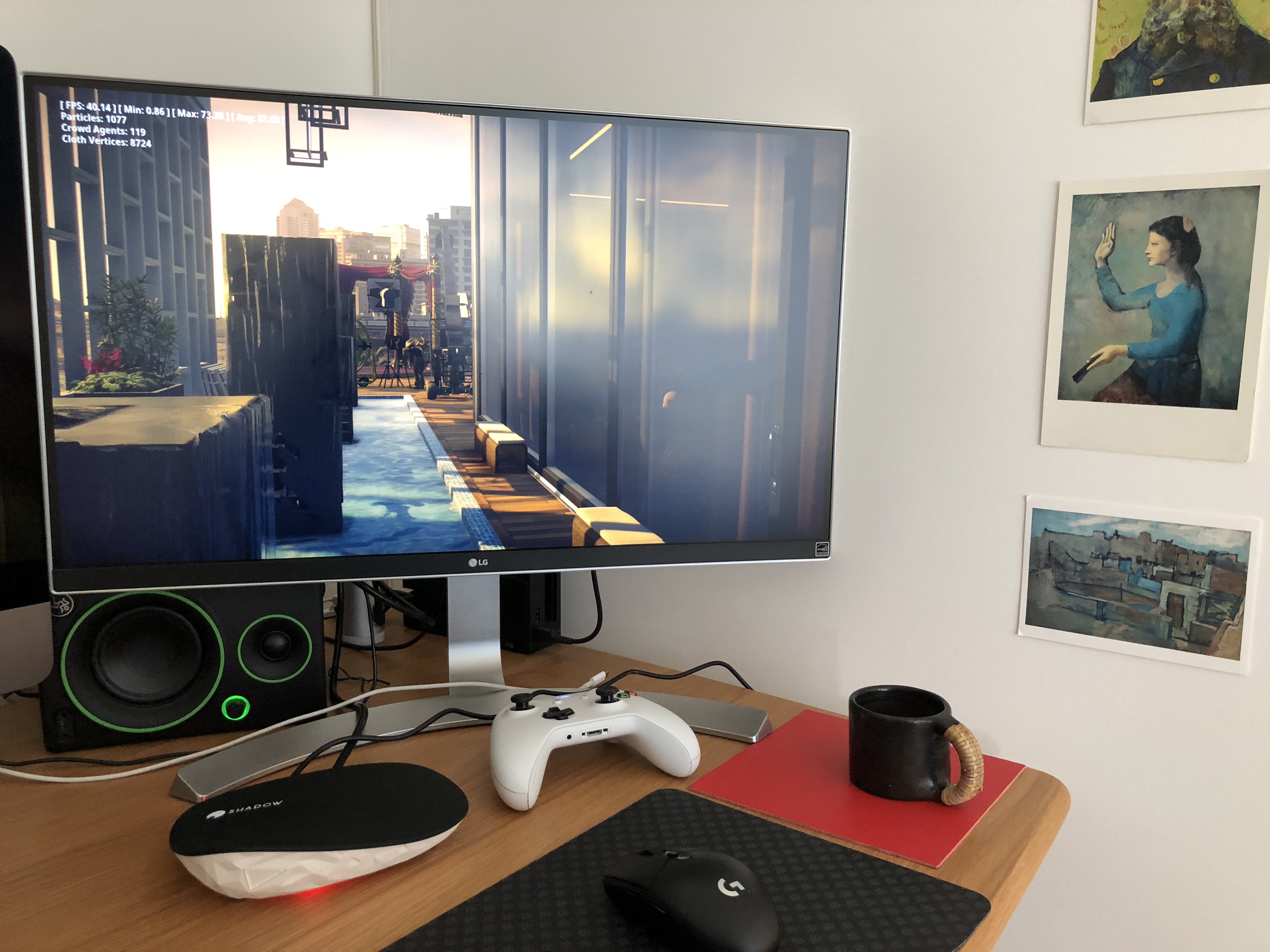
The original Shadow box was a bit clunky. You could hear the fan, you had to rely on dongles if you wanted to pair a Bluetooth device or connect to a Wi-Fi network and there was no HDMI port — only DisplayPort. Internally, Blade has been debating whether the company needs another box.
In 2017, it was too hard to explain the product without some sort of physical device — you can replace a PC tower with a tiny box. But now that gamers understand the benefits of cloud gaming, there’s no reason to force you to buy a box.
And yet, the Shadow Ghost can be a useful little device in some cases. For instance, while the company has released an Android TV app and is testing a new app for the Apple TV, your current TV setup might not be compatible with Shadow. Or maybe you primarily use a laptop and you want to create a desktop PC setup with a display, a keyboard, a mouse and a Shadow Ghost.
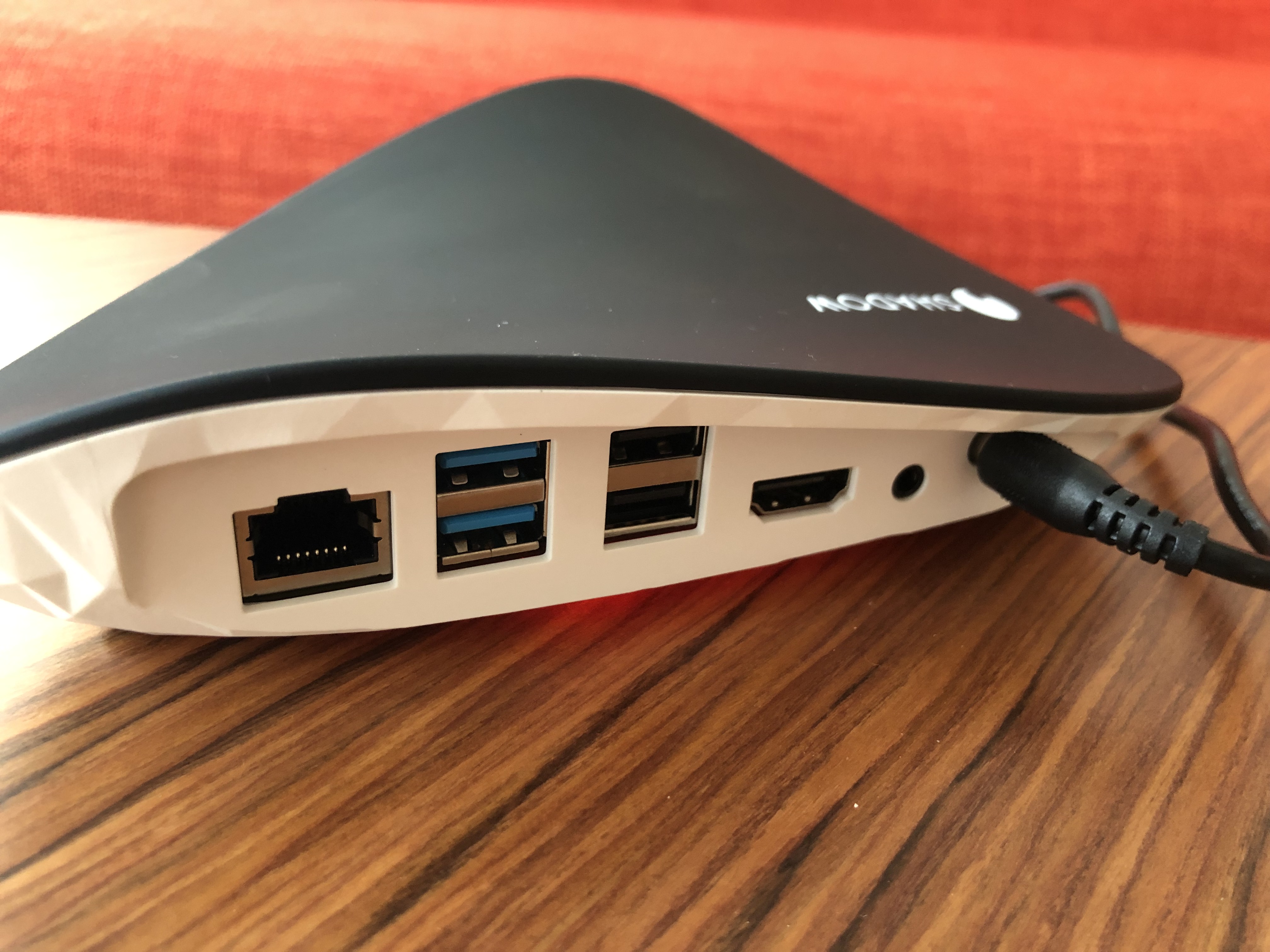
Everything has been improved. It is now a fanless device that consumes less than 5W when it’s on. It has an Ethernet port, two USB 3.0 ports, two USB 2.0 ports, an audio jack and a single HDMI port. Bluetooth and Wi-Fi have finally been integrated in the device.
When you boot up the device, you get a menu to connect to a Wi-Fi network or control your Bluetooth devices. You can also change some streaming settings, like in the app launcher.
Once you press the start button, the video stream starts and it feels like you’re using a Windows computer. With Steam’s Big Picture mode, you get a convenient setup for couch gaming. I had no issue playing demanding games, such as Hitman 2. It works perfectly fine with a Wi-Fi connection and a Bluetooth controller.
Using the Shadow Ghost feels just like using the Shadow app on a computer. So it’s hard to say whether you need the Shadow Ghost or not. It depends on your setup at home and how you plan on using the service.
Last summer, Blade planned to manufacture 5,000 units. But now that the user base has grown significantly, that first batch could disappear in no time. It is available starting today for $140.
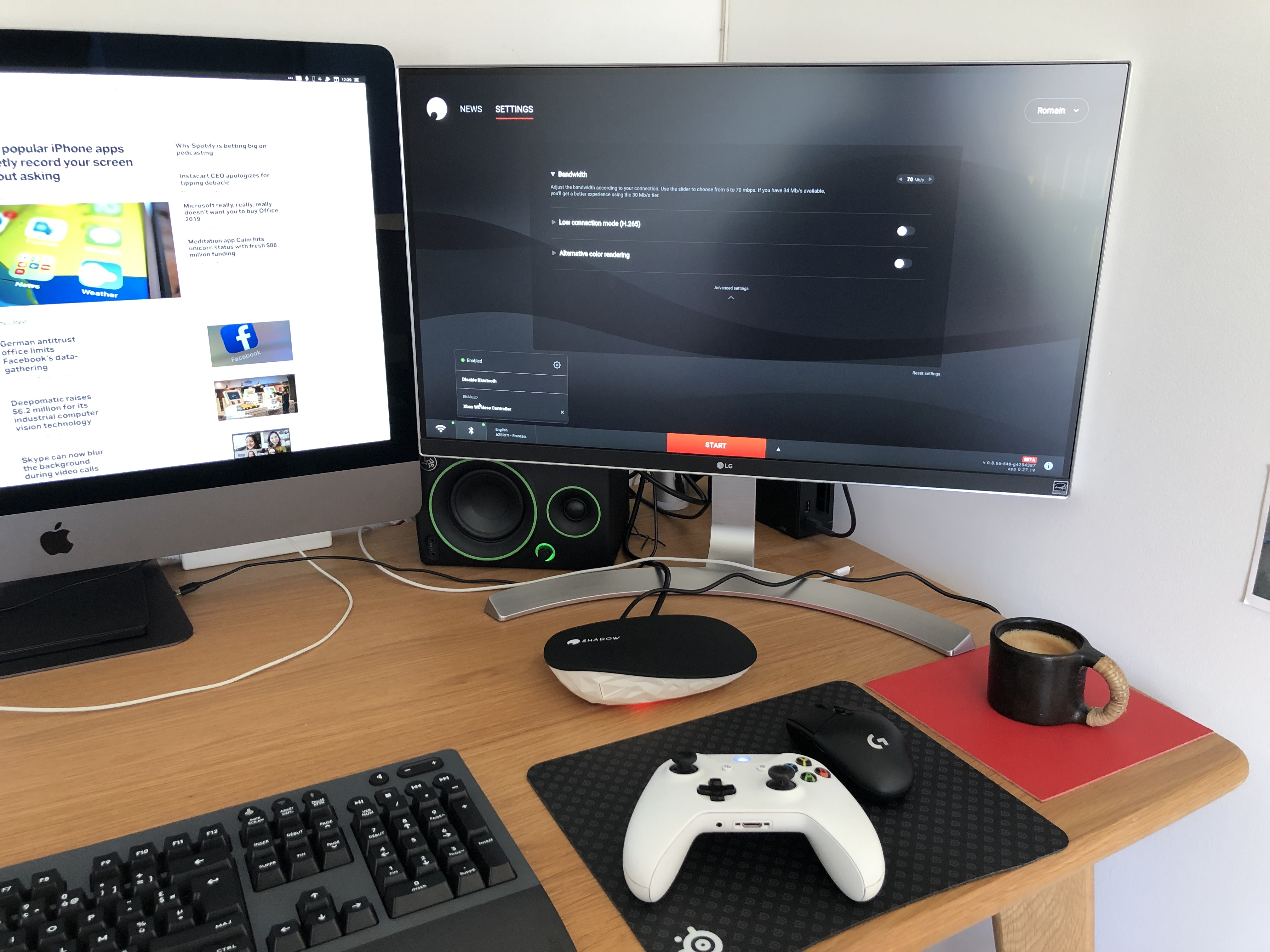
Cloud gaming is a hot space right now. While some companies have been experimenting with this concept for a while (Nvidia, Sony), it feels like everyone is working on a new service of some sort. Maybe the next Xbox is going to be about streaming a game from a data center. Maybe Amazon will offer a game library in the cloud as part of your Amazon Prime subscription.
Emmanuel Freund believes that it could be an opportunity for Shadow. Everybody is going to talk about cloud gaming if Apple and Google announce new services. But the startup has years of experiences in the space and has tried hard to compensate when it comes to latency and internet speeds.
It’s going to be harder to compete on content though. Game publishers and console manufacturers could start releasing exclusive titles on their cloud gaming services. That’s why Blade is thinking about new gaming experiences and exclusive content that would make Shadow more than a technical service.
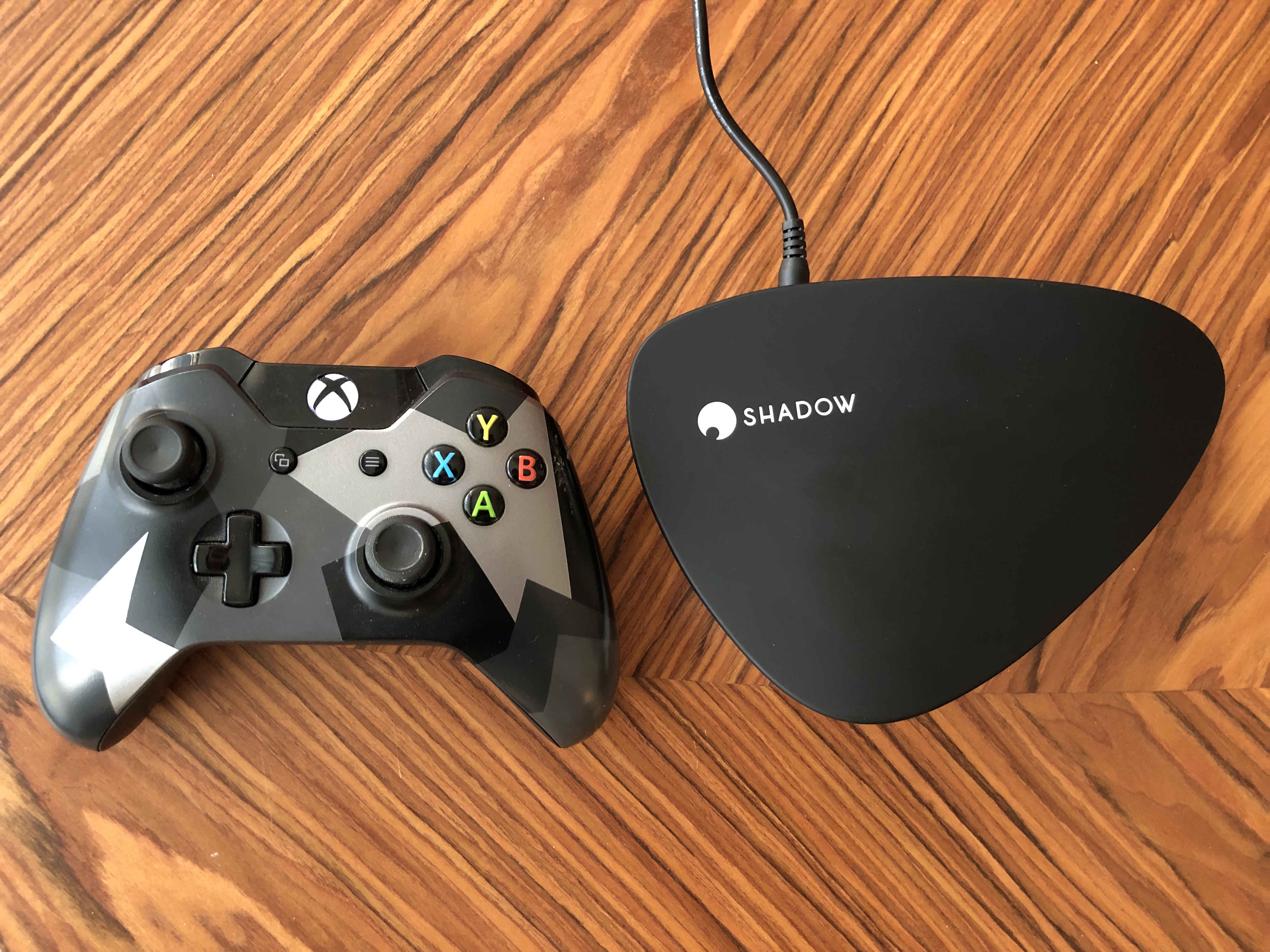
(Controller for scale)
Come comment on this article: CEO claims Snapchat’s new Android app to be finished in 2019
Researchers have created a prosthetic hand that offers its users the ability to feel where it is and how the fingers are positioned — a sense known as proprioception. The headline may be in jest, but the advance is real and may help amputees more effectively and naturally use their prostheses.
Prosthesis rejection is a real problem for amputees, and many choose to simply live without these devices, electronic or mechanical, since they can complicate as much as they simplify. Part of that is the simple fact that, unlike their natural limbs, artificial ones have no real sensation — or if there is any, it’s nowhere near the level someone had before.
Touch and temperature detection are important, of course, but what’s even more critical to ordinary use is simply knowing where your limb is and what it’s doing. If you close your eyes, you can tell where each digit is, how many you’re holding up, whether they’re gripping a small or large object, and so on. That’s currently impossible with a prosthesis, even one that’s been integrated with the nervous system to provide feedback — meaning users have to watch what they’re doing at all times. (That is, if the arm isn’t watching for you.)
This prosthesis, built by Swiss, Italian, and German neurologists and engineers, is described in a recent issue of Science Robotics. It takes the existing concept of sending touch information to the brain through electrodes patched into the nerves of the arm, and adapts it to provide real-time proprioceptive feedback.
 “Our study shows that sensory substitution based on intraneural stimulation can deliver both position feedback and tactile feedback simultaneously and in real time. The brain has no problem combining this information, and patients can process both types in real time with excellent results,” explained Silvestro Micera, of the École Polytechnique Fédérale de Lausanne, in a news release.
“Our study shows that sensory substitution based on intraneural stimulation can deliver both position feedback and tactile feedback simultaneously and in real time. The brain has no problem combining this information, and patients can process both types in real time with excellent results,” explained Silvestro Micera, of the École Polytechnique Fédérale de Lausanne, in a news release.
It’s been the work of a decade to engineer and demonstrate this possibility, which could be of enormous benefit. Having a natural, intuitive understanding of the position of your hand, arm, or leg would likely make prostheses much more useful and comfortable for their users.
Essentially the robotic hand relays its telemetry to the brain through the nerve pathways that would normally be bringing touch to that area. Unfortunately it’s rather difficult to actually recreate the proprioceptive pathways, so the team used what’s called sensory substitution instead. This uses other pathways, like ordinary touch, as ways to present different sense modalities.
A simple example would be a machine that touched your arm in a different location depending on where your hand is. In the case of this research it’s much finer, but still essentially presenting position data as touch data. It sounds weird, but our brains are actually really good at adapting to this kind of thing.
As evidence witness that after some training two amputees using the system were able to tell the difference between four differently shaped objects being grasped, with their eyes closed, with 75 percent accuracy. Chance would be 25 percent, of course, meaning the sensation of holding objects of different sizes came through loud and clear — clear enough for a prototype, anyway. Amazingly, the team was able to add actual touch feedback to the existing pathways and the users were not overly confused by it. So there’s precedent now for multi-modal sensory feedback from an artificial limb.
The study has well-defined limitations, such as the number and type of fingers it was able to relay information from, and the granularity and type of that data. And the “installation” process is still very invasive. But it’s pioneering work nevertheless: this type of research is very iterative and global, progressing by small steps until, all of a sudden, prosthetics as a science has made huge strides. And the people who use prosthetic limbs will be making strides as well.
Come comment on this article: Huawei Watch GT review: A smartwatch for people that hate smartwatches
Come comment on this article: [TA Deals] Save almost 70% on a RoboForm Everywhere password manager subscription
Come comment on this article: These are the best things we’ve seen at MWC 2019
Come comment on this article: Samsung’s Galaxy S10 phones will have McAfee pre-installed
Come comment on this article: Google is adding Assistant to Messages before killing Allo
Today at MWC Barcelona OnePlus CEO Pete Lau unveiled an initiative to spur apps for 5G networks. The timing is right, too. With 5G launching around the world this year, carriers, phone makers and consumers alike have yet to develop a killer app for the massive increase of speed provided by 5G. Basically, OnePlus is asking for help developing uses for 5G.
OnePlus sees a lacking of imagination around 5G in the long term. Speaking on a panel, CEO Pete Lau stated he does not believe people have thought enough about how 5G can change lives in the long term.
This contest will select 20 finalists, who will get OnePlus devices. The winners will get a trip to OnePlus HQ and access to 5G testing labs, and support from Oneplus and EE.
Such contest were common around the launch of 4G as mobile device makers were attempting to bolster app marketplaces. But 5G apps, could look much different from 4G apps as much of the processing is offloaded to a central data center instead of happening on the device.
The promise of 5G is nearly here, but it will take initiatives and programs like this one from OnePlus to help make the possibilities clear to consumers.
Come comment on this article: [TA Deals] Save over 90% on the Complete Front-End Developer bundle!
Last month I wrote about Ubiquitilink, which promised, through undisclosed means, it was on the verge of providing a sort of global satellite-based roaming service. But how, I asked? (Wait, they told me.) Turns out our phones are capable of a lot more than we think: they can reach satellites acting as cell towers in orbit just fine, and the company just proved it.
Utilizing a constellation of satellites in low Earth orbit, Ubiquitilink claimed during a briefing at Mobile World Congress in Barcelona that pretty much any phone from the last decade should be able to text and do other low-bandwidth tasks from anywhere, even in the middle of the ocean or deep in the Himalayas. Literally (though eventually) anywhere and any time.
Surely not, I hear you saying. My phone, that can barely get a signal on some blocks of my neighborhood, or in that one corner of the living room, can’t possibly send and receive data from space… can it?
“That’s the great thing — everybody’s instinct indicates that’s the case,” said Ubiquitilink founder Charles Miller. “But if you look at the fundamentals of the RF [radio frequency] link, it’s easier than you think.”
The issue, he explained, isn’t really that the phone lacks power. The limits of reception and wireless networks are defined much more by architecture and geology than plain physics. When an RF transmitter, even a small one, has a clear shot straight up, it can travel very far indeed.
It’s not quite as easy as that, however; there are changes that need to be made, just not anything complex or expensive like special satellite antennas or base stations. If you know that modifying the phone is a non-starter, you have to work with the hardware you’ve got. But everything else can be shaped accordingly, Miller said – three things in particular.
Having adjusted for these things, an ordinary phone can contact and trade information with a satellite with its standard wireless chip and power budget. But there’s one more obstacle, one Ubiquitilink spent a great deal of time figuring out.
Although a phone and satellite can reach one another reliably, a delay and doppler shift in the signal due to the speeds and distances involved are inescapable. Turns out the software that runs towers and wireless chips isn’t suited for this; the timings built into the code assume the distance will be less than 30 km, since the curvature of the Earth generally prevents transmitting further than that.
So Ubiquitilink modified the standard wireless stacks to account for this, something Miller said no one else had done.
“After my guys came back and told me they’d done this, I said, well let’s go validate it,” he told me. “We went to NASA and JPL and asked what they thought. Everybody’s gut reaction was ‘well, this won’t work,’ but then afterwards they just said ‘well, it works.’ ”
 The theory became a reality earlier this year after Ubiquitilink launched their prototype satellites. They successfully made a two-way 2G connection between an ordinary ground device and the satellite, proving that the signal not only gets there and back, but that its doppler and delay distortions can be rectified on the fly.
The theory became a reality earlier this year after Ubiquitilink launched their prototype satellites. They successfully made a two-way 2G connection between an ordinary ground device and the satellite, proving that the signal not only gets there and back, but that its doppler and delay distortions can be rectified on the fly.
“Our first tests demonstrated that we offset the doppler shift and time delay. Everything else is leveraging commercial software,” Miller said, though he quickly added: “To be clear, there’s plenty more work to be done, but it isn’t anything that’s new technology. It’s good solid hardcore engineering, building nanosats and that sort of thing.”
Since his previous company was Nanoracks and he’s been in the business for decades, he’s qualified to be confident on this part. It’ll be a lot of work and a lot of money, but they should be launching their first real satellites this summer. (And it’s all patented, he noted.)
The way the business will work is remarkably simple given the complexity of the product. Because the satellites operate on modified but mostly ordinary off-the-shelf software and connect to phones with no modifications necessary, Ubiquitilink will essentially work as a worldwide roaming operator that mobile networks will pay for access to. (Disclosure: Verizon, obviously a mobile network, owns TechCrunch, and for all I know will use this tech eventually. It’s not involved with any editorial decisions.)
Normally, if you’re a subscriber of network X, and you’re visiting a country where X has no coverage, X will have an agreement with network Y, which connects you for a fee. There are hundreds of these deals in play at any given time, and Ubiquitilink would just be one more — except its coverage will eventually be global. Maybe you can’t reach X or Y, you’ll always be able to reach U.
The speeds and services available will depend on what mobile networks want. Not everyone wants or needs the same thing, of course, and a 3G fallback might be practical where an LTE connection is less so. But the common denominator will be data enough to send and receive text at the least.
It’s worth noting also that this connection will be in some crucial ways indistinguishable from other connections: it won’t affect encryption, for instance.
This will of course necessitate at least a thousand satellites, by Miller’s count. But in the meantime limited service will also be available in the form of timed passes — you’ll have no signal for 55 minutes, then signal for five, during which you can send and receive what may be a critical text or location. This is envisioned as a specialty service at first, then as more satellites join the constellation, that window expands until it’s 24/7 and across the whole face of the planet, and it becomes a normal consumer good.
While your network provider will probably charge you the usual arm and leg for global roaming on demand (it’s their prerogative), there are some services Ubiquitilink will provide for free; the value of a global communication system is not lost on Miller.
“Nobody should ever die because the phone in their pocket doesn’t have signal,” he said. “If you break down in the middle of Death Valley you should be able to text 911. Our vision is this is a universal service for emergency responders and global E-911 texting. We’re not going to charge for that.”
An emergency broadcast system when networks are down is also being planned — power outages following disasters are times when people are likely to panic or be struck by a follow-up disaster like a tsunami or flooding, and reliable communications at those times could save thousands and vastly improve recovery efforts.
“We don’t want to make money off saving people’s lives, that’s just a benefit of implementing this system, and the way it should be,” Miller said.
It’s a whole lot of promises, but the team and the tech seem capable of backing them up. Initial testing is complete and birds are in the air — now it’s a matter of launching the next thousand or so.
Come comment on this article: Lenovo launches new 14-inch portable monitor
Come comment on this article: Sprint and HTC team up to release a 5G Hub smart home box
Come comment on this article: Lenovo launching their own branded headphones
Come comment on this article: BlackBerry refreshes the Key2 with a new paint job and more storage
Come comment on this article: MicroSD cards will soon be available with 1TB of storage
Come comment on this article: Sony Xperia 10 and 10 Plus join the Xperia 1 at MWC 2019
Come comment on this article: Sprint will be the first carrier to sell LG’s V50 ThinQ 5G
Come comment on this article: LG’s V50 ThinQ 5G and G8 ThinQ are a strange mix of bland design and innovation
Telecom company Sprint has shared some of its plans when it comes to 5G service in the U.S. The company announced at MWC in Barcelona that mobile customers in Atlanta, Chicago, Dallas and Kansas City can expect 5G service as soon as May 2019.
If you don’t live in one of those cities, maybe you live in Houston, Los Angeles, New York City, Phoenix or Washington D.C. Sprint also promises 5G coverage in those cities soon after the initial launch, at some point before the end of June 2019.
Overall, Sprint expects to cover 1,000 square miles in nine cities by the end of the first half of 2019. It’s going to take years to roll out 5G coverage across the U.S.
When it comes to devices, Sprint will sell smartphones that are compatible with its 5G network. The first one will be the LG V50 ThinQ 5G. The company will also sell the Samsung Galaxy S10 5G at some point this summer.
Sprint is also partnering with Google so that Google Fi customers can take advantage of Sprint’s 5G network if they have a compatible device.
And that’s about all there’s to know. It’s still unclear whether 5G plans are going to cost more.
Disclosure: Sprint competitor Verizon owns TechCrunch
Come comment on this article: Sony Xperia 1 with 21:9 ‘4K’ OLED display and 4 cameras launched at MWC 2019
Today MWC Barcelona the SD Association unveiled microSD Express that will allow future mobile devices to consume and create content at even faster speeds. This new microSD card platform boosts incredible transfer speeds while consuming less energy used by previous formats.
The new format will be available in the flavors of microSDHC Express, microSDXC Express and microSDUC Express.
Like SD Express, microSD Express taps the PCIe interface to hit a maximum data transfer rate of 985 megabytes per second (MB/s). This is possible through the PCIe 3.1 and NVMe v1.3 specifications that live on a second row of pins. The SD Association expects the faster cards to consume less energy than traditional memory cards while still being backwards compatible.
The fast data speeds could lead mobile device makers to rethink how they equip devices. Read and write speeds have long been a limiting factor for expandable memory, but with this new format, that’s backwards compatible, the data transfer happens nearly as quick as built-in memory. With 5G data and cameras pumping out huge files, expandable memory could make a comeback.
Want more technical information about #microSDExpress? Learn more in our newest whitepaper: https://t.co/SyVdzdwGbN pic.twitter.com/3kmsdvjJhh
— SD Association (@SD_Association) February 25, 2019
Qualcomm today announced new 4g and 5g chipsets for connected vehicles. The chip maker sees the advanced communication platforms powering the next wave of in-vehicle experiences and telematics features including advanced automotive safety features and self-driving cars. Qualcomm says vehicles equipped with these chipsets are planned for production in 2021.
The Qualcomm Snapdragon Automotive 4G and Qualcomm Snapdragon Automotive 5G Platform feature C-V2X direct communications, high-precision multi-frequency global navigation satellite system (HP-GNSS) and RF Front-End (RFFE) functionalities — basically, the chipsets will give vehicles next level positioning capabilities.
Along with improved positioning, vehicles equipped with these Snapdragon platforms gain vehicle-to-vehicle and vehicle-to-infrastructure communications.
The Snapdragon Automotive 5G chipset is the first in the industry announced with support for dual SIM dual active — or DSDA, for short.
Qualcomm says it intends to give automakers the ability to test the platforms with a reference design kit in the second half of 2019.
It’s through chipsets like these that vehicles will gain autonomous driving capabilities. Without advanced, reliable connectivity, vehicles will not have access to the data needed to navigate across the ever-evolving urban landscape. While current systems are being used to some level of success, improved connectivity is ultimately needed to make good on the promise of self-driving cars.
Qualcomm today announced new 4g and 5g chipsets for connected vehicles. The chip maker sees the advanced communication platforms powering the next wave of in-vehicle experiences and telematics features including advanced automotive safety features and self-driving cars. Qualcomm says vehicles equipped with these chipsets are planned for production in 2021.
The Qualcomm Snapdragon Automotive 4G and Qualcomm Snapdragon Automotive 5G Platform feature C-V2X direct communications, high-precision multi-frequency global navigation satellite system (HP-GNSS) and RF Front-End (RFFE) functionalities — basically, the chipsets will give vehicles next level positioning capabilities.
Along with improved positioning, vehicles equipped with these Snapdragon platforms gain vehicle-to-vehicle and vehicle-to-infrastructure communications.
The Snapdragon Automotive 5G chipset is the first in the industry announced with support for dual SIM dual active — or DSDA, for short.
Qualcomm says it intends to give automakers the ability to test the platforms with a reference design kit in the second half of 2019.
It’s through chipsets like these that vehicles will gain autonomous driving capabilities. Without advanced, reliable connectivity, vehicles will not have access to the data needed to navigate across the ever-evolving urban landscape. While current systems are being used to some level of success, improved connectivity is ultimately needed to make good on the promise of self-driving cars.
Oppo VP Brian Shen took to Weibo today to unveil the company’s foldable phone concept. It looks like the same kit used by Huawei and it’s unclear if Oppo will release the device. Shen notes the company doesn’t think a foldable phone improves the user experience, which is why the company is hesitant to move the device into production.
This is a smart move from the Chinese phone company.
Oppo VP Brian Shen says the company is observing the response from consumers before releasing its foldable phone to consumers.
Samsung and Huawei touted their foldable phones as the next great thing while the general response has been tepid at best. Foldable phones, at their core, offer the same features as standard phones and rely on the imagination of the user to create a killer use case. And without a killer use case, foldable phones will never take off.
Come comment on this article: Nokia’s new line of phones drops at MWC 2019, including the PureView 9 with five cameras
Come comment on this article: Forget the Galaxy Fold, Huawei’s 5G foldable smartphone has the X factor
Microsoft unveiled the latest version of its HoloLens ‘mixed reality’ headset at MWC Barcelona today. The new HoloLens 2 features a significantly larger field of view, higher resolution and a device that’s more comfortable to wear. Indeed, Microsoft says the device is three times as comfortable to wear (though it’s unclear how Microsoft measured this).
Later this year, HoloLens 2 will be available in the United States, Japan, China, Germany, Canada, United Kingdom, Ireland, France, Australia and New Zealand for $3,500.
One of the knocks against the original HoloLens was its limited field of view. When whatever you wanted to look at was small and straight ahead of you, the effect was striking. But when you moved your head a little bit or looked at a larger object, it suddenly felt like you were looking through a stamp-sized screen. HoloLens 2 features a field of view that’s twice as large as the original.
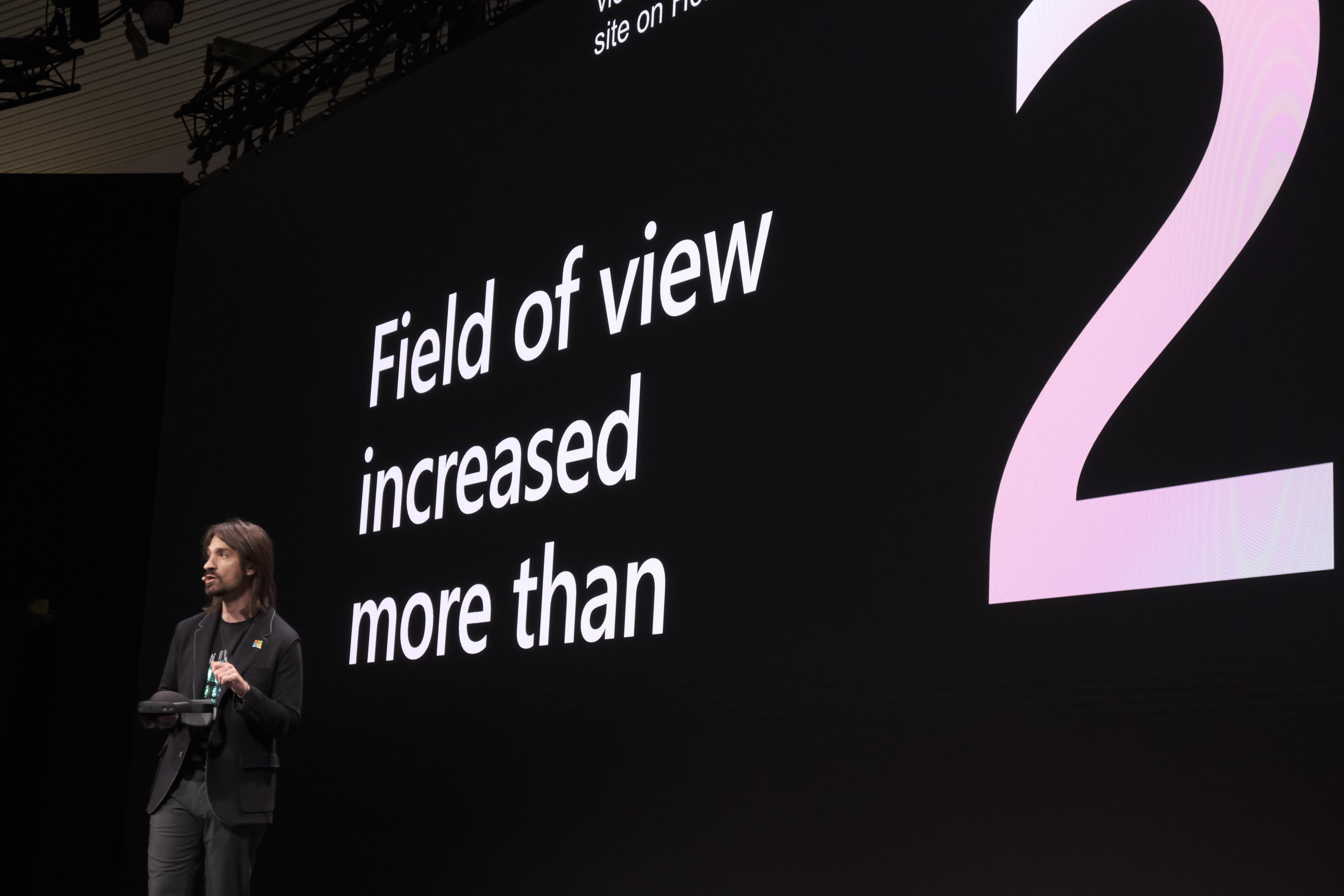
“Kinect was the first intelligent device to enter our homes,” HoloLens chief Alex Kipman said in today’s keynote, looking back the the device’s history. “It drove us to create Microsoft HoloLens. […] Over the last few years, individual developers, large enterprises, brand new startup have been dreaming up beautiful things, helpful things.”
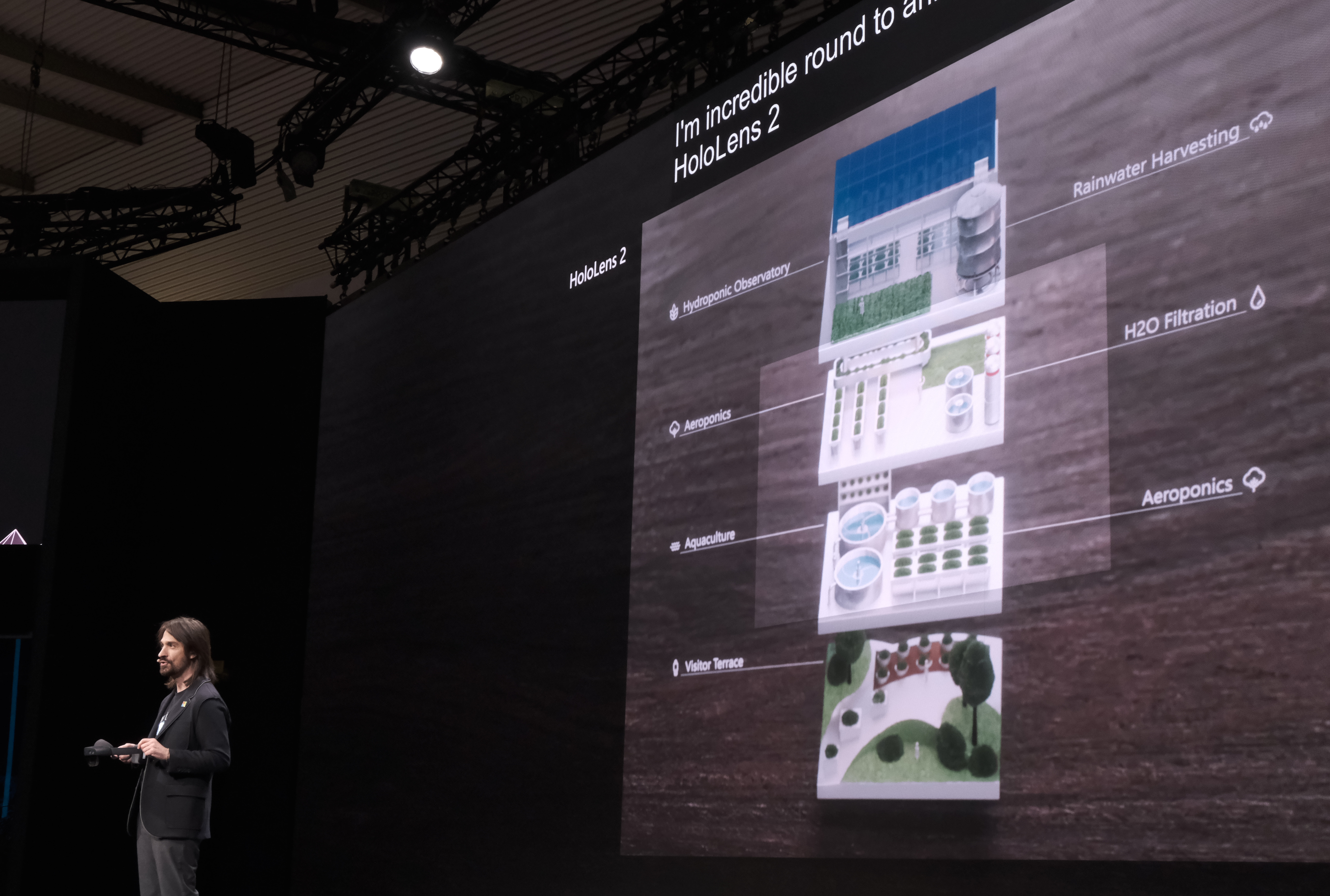
The HoloLens was always just as much about the software as the hardware, though. For HoloLens, Microsoft developed a special version of Windows, together with a new way of interacting with the AR objects through gestures like air tap and bloom. In this new version, the interaction is far more natural and lets you tap objects. The device also tracks your gaze more accurately to allow the software to adjust to where you are looking.
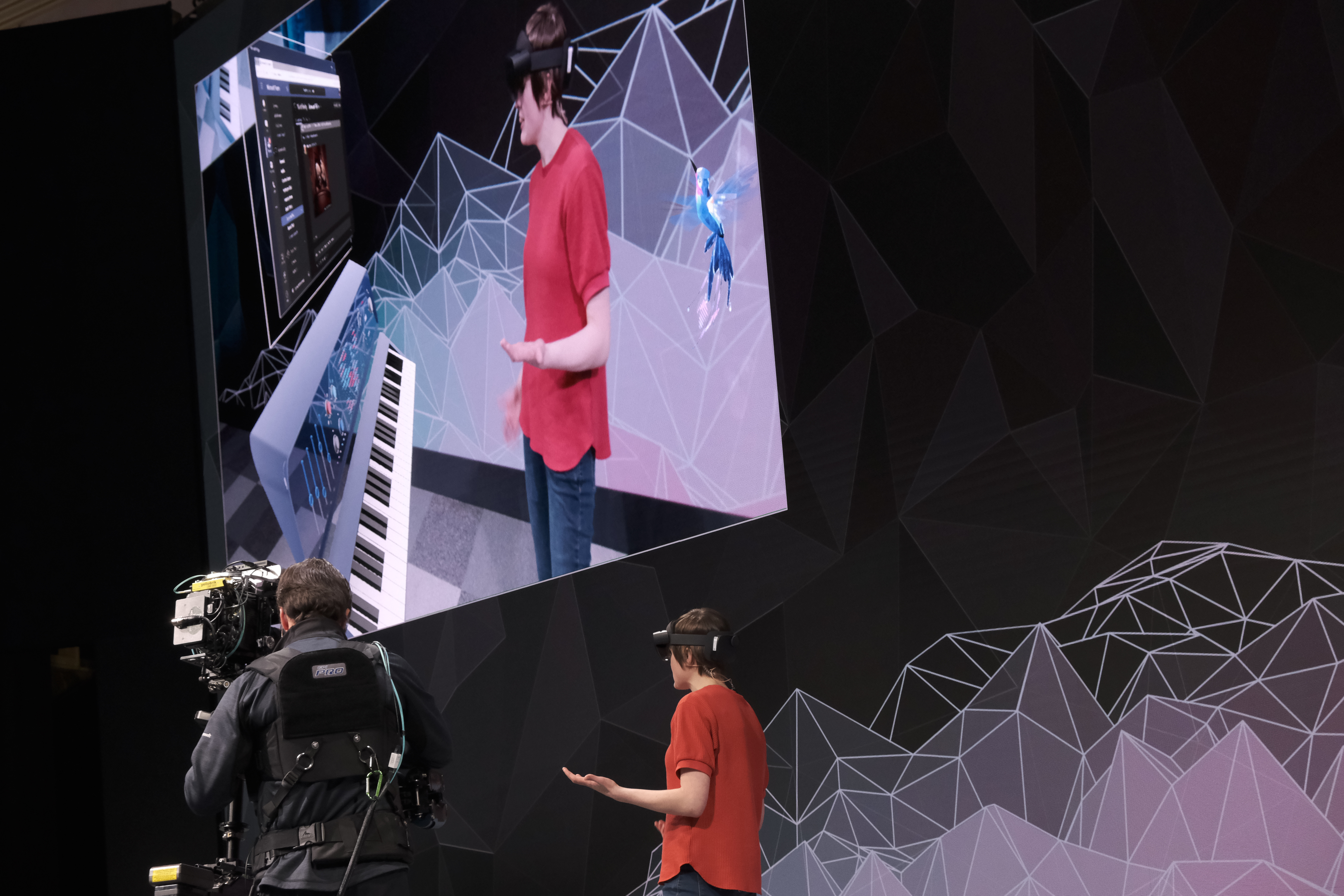
“HoloLens 2 adapts to you,” Kipman stressed. “HoloLens 2 evolves the interaction model by significantly advancing how people engage with holograms.”
In its demos, the company clearly emphasized how much faster and fluid the interaction with HoloLens applications becomes when you can use slides, for example, by simply grabbing the slider and moving it, or by tapping on a button with either a finger or two or with your full hand. Microsoft event built a virtual piano that you can play with ten fingers to show off how well the HoloLens can track movement. The company calls this ‘instinctual interaction.’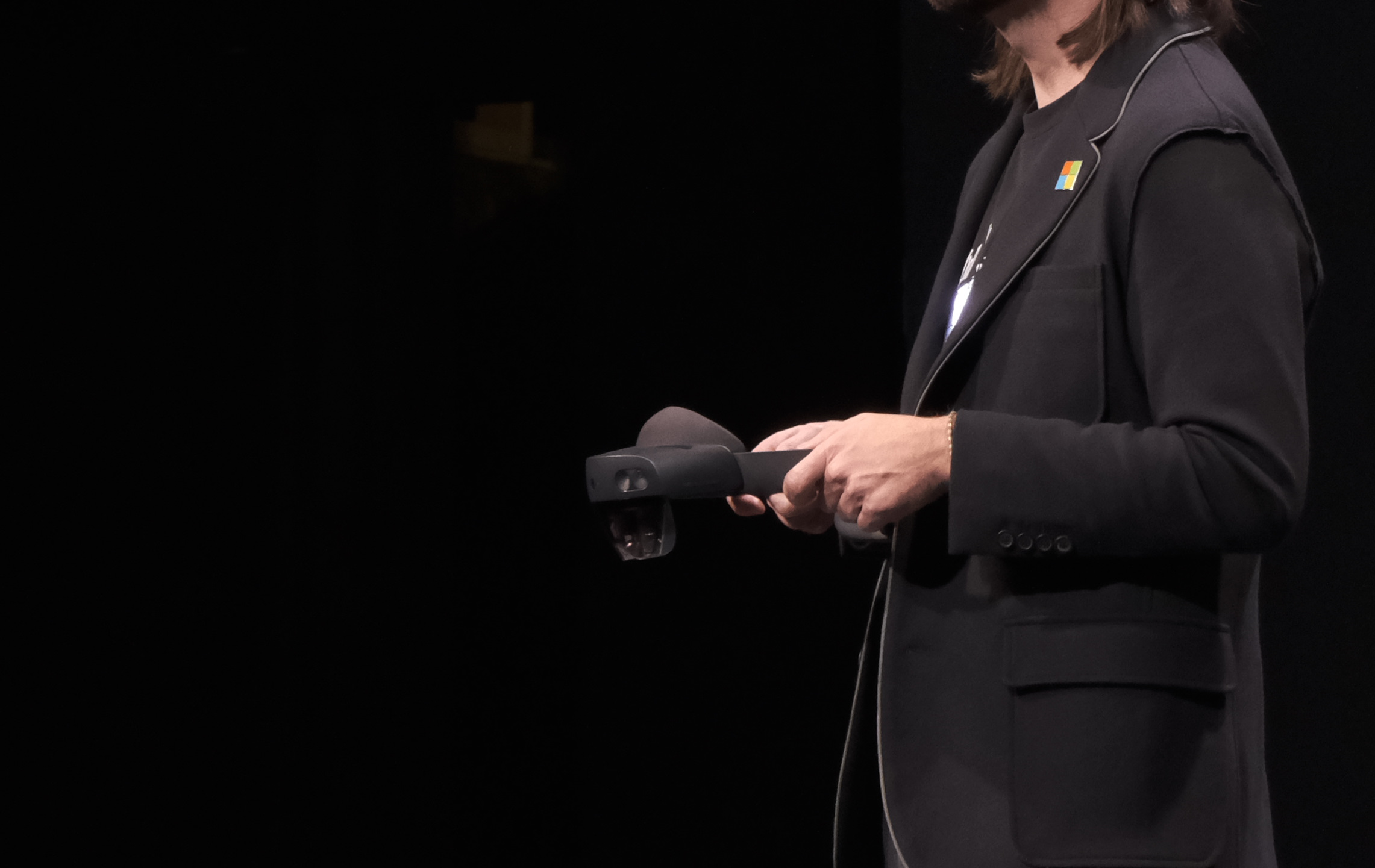
Microsoft first unveiled the HoloLens concept at a surprise event on its Redmond campus back in 2015. After a limited, invite-only release that started days after the end of MWC 2016, the device went on sale to everybody in August 2016. Four years is a long time between hardware releases, but the company clearly wanted to seed the market and give developer a chance to build the first set of HoloLens applications on a stable platform.
To support developers, Microsoft is also launching a number of Azure services for HoloLens today. These include spatial anchors and remote rendering to help developers stream high-polygon content to HoloLens.
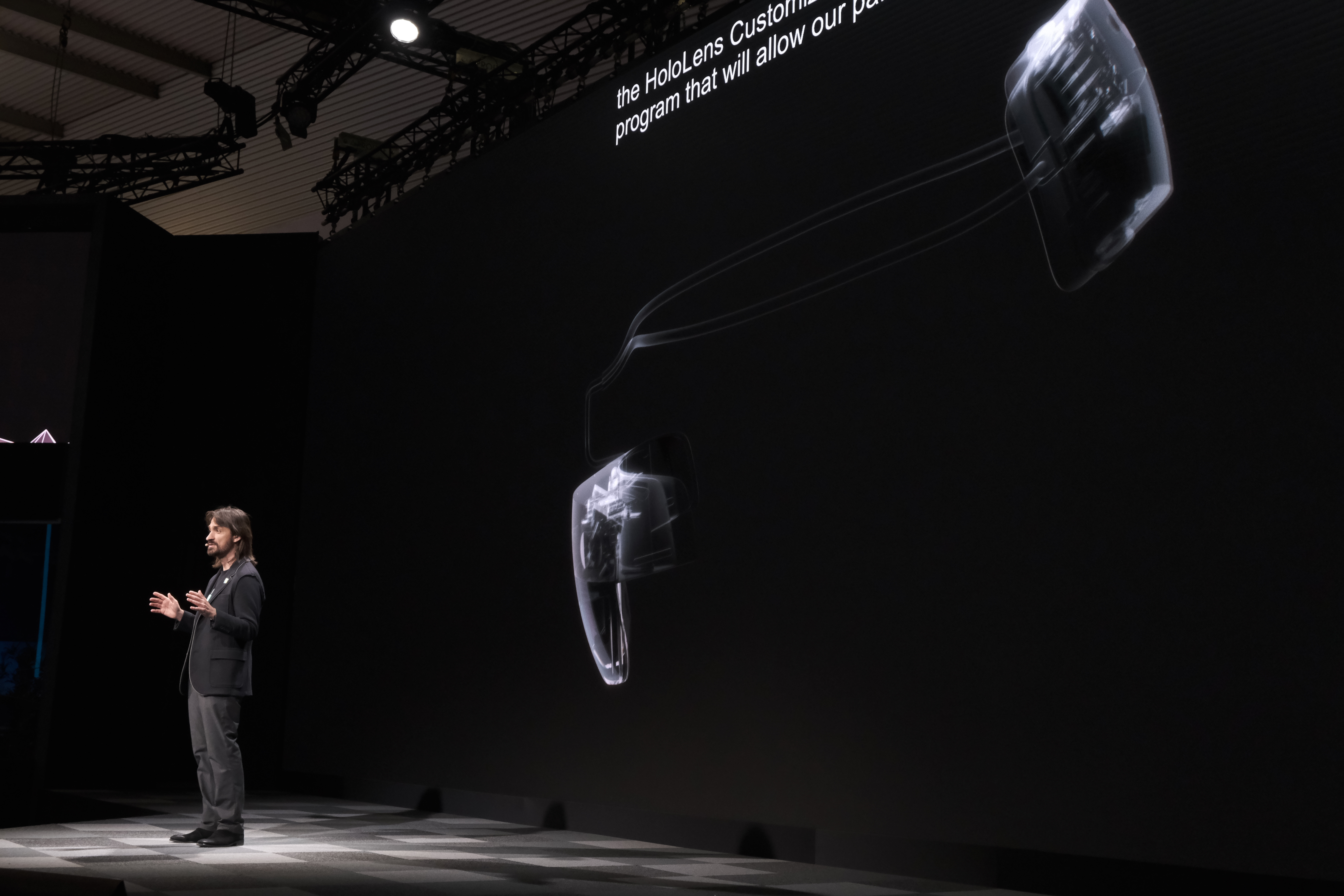
It’s worth noting that Microsoft never positioned the device as consumer hardware. I may have shown off the occasional game, but its focus was always on business applications, with a bit of educational applications thrown in, too. That trend continued today. Microsoft showed off the ability to have multiple people collaborate around a single hologram, for example. That’s not new, of course, but goes to show how Microsoft is positioning this technology.
For these enterprises, Microsoft will also offer the ability to customize the device.
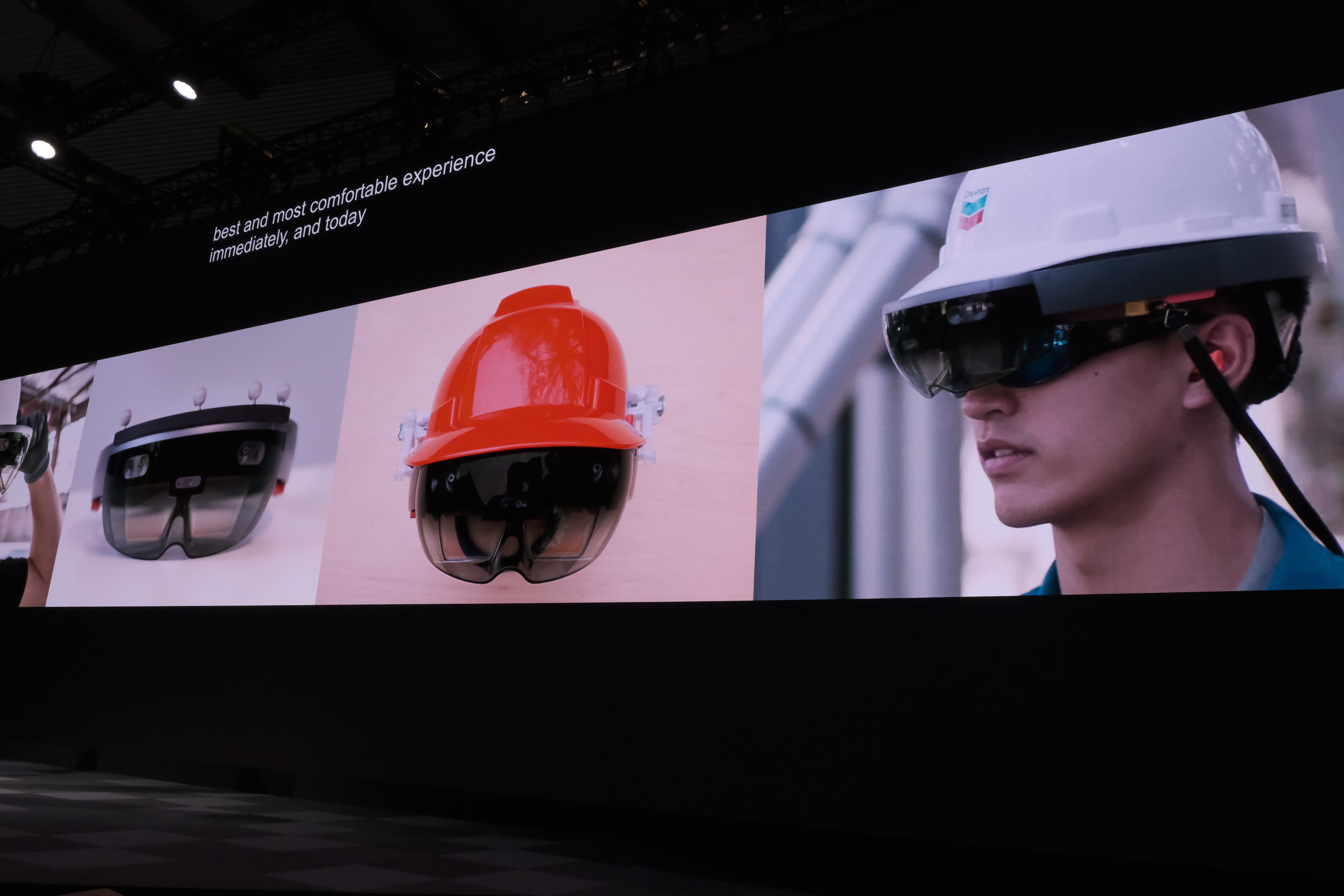
“When you change the way you see the world, you change the world you see,” Microsoft CEO Satya Nadella said, repeating a line from the company’s first HoloLens announcement four years ago. He noted that he believes that connecting the physical world with the virtual world will transform the way we will work.
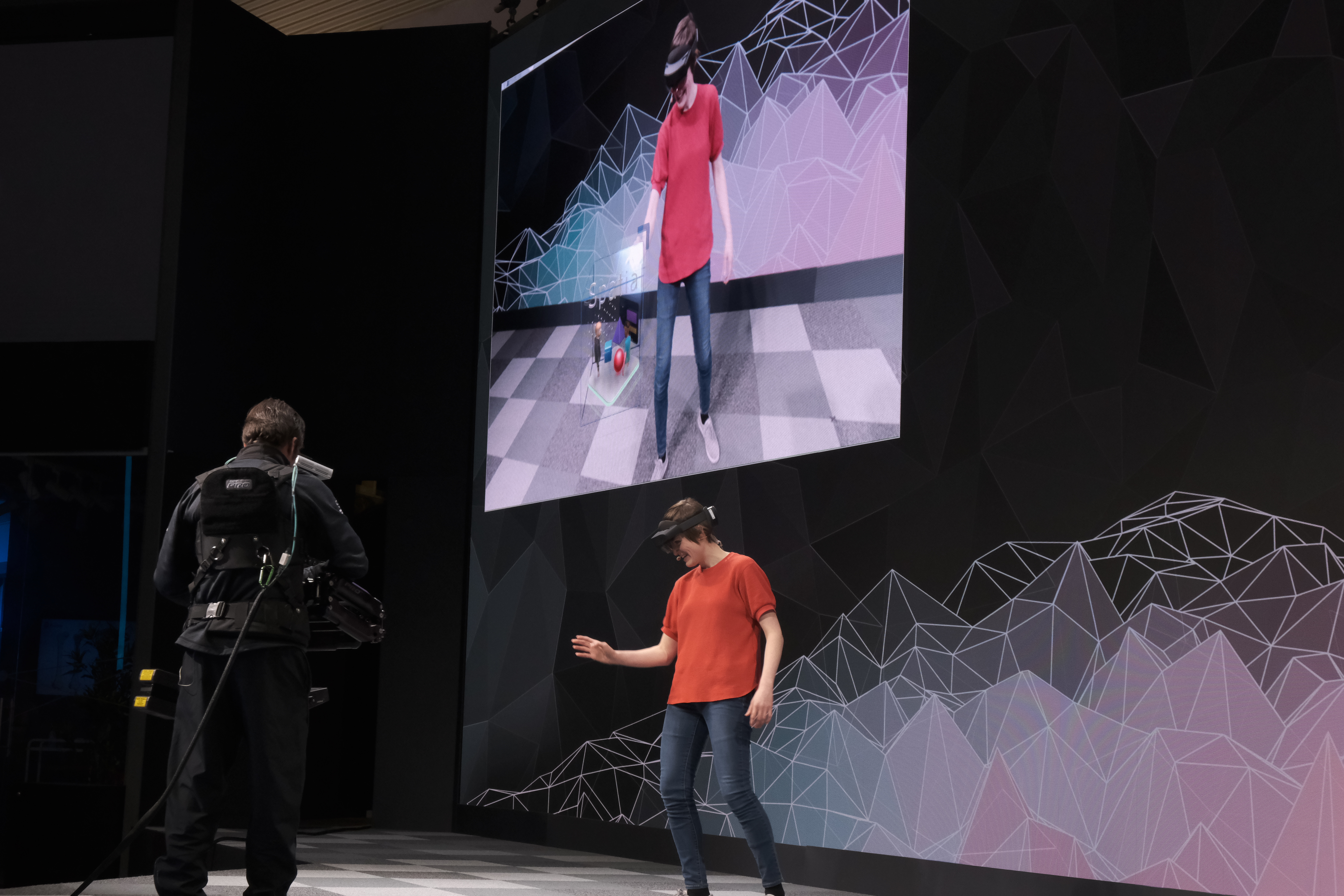
Today at MWC Barcalona Huawei launched its first consumer 5G products. Aside from its 5G Mate 20 X, the company also updated and new products that will bring 5G to people’s homes and devices through routers and connectivity options. Most consumers will first taste 5G not on a dedicated device like a phone, but through broadband-like services and these devices are aimed at that market.
Last year, Huawei announced the 5G CPE Pro but never took it to market. Then, last month, ahead of MWC Barcelona, Huawei announced a new version alongside its new Balong 5000 5G chipset, which is at the heart of its consumer 5G products.
Huawei’s Balong 5000 brings added connectivity options over the company’s previous 5G chipsets. Huawei claims the Balong 5000 is the first chip that supports both standalone (SA) and non-standalone (NSA) network architectures for 5G allowing it connect to existing supercharged 4G networks as well as future 5G networks. It also packs the goods to support vehicle to every communication signaling Huawei’s commitment to infrastructure support.
The company says the Balong 5000 chip can achieve download speeds of 4.6 Gbps and 6.5 Gbps depending on if connected to Sub-6 GHz or high-frequency bands for extended spectrum.
The new 5G CPE Pro packs the Balong 5000 chip along with WiFi 6, which is key to serving 5G’s added speed to devices. With WiFi 6 the CPE Pro can deliver local network speeds of up to 4.8 Gbps.
The 5G CPE Win uses the same Balong 5000 chip and is being positioned as home receiver. It’s weather-proof and can be mounted to a wall, pole, or windowsill and serves network through the house through WiFi or Power Over Ethernet.
The 5G Mobile WiFi is an updated version of a product Huawei announced last year. Like the 5G CPE Pro, the product now features Huawei’s Balong 5000 allowing it connect to existing 4G networks and future 5G networks.
At this time the company did not reveal availability or pricing for any of the above products. Chances are though, giving the company’s legal issues in the States, these products likely will not be available in that market.
Today at MWC Barcelona Huawei announced it will bring 5G to its flagship phone, the Mate 20 X. This marks the first 5G phone from the Chinese mobile giant. Huawei joins a growing list of companies introducing their first 5G phone in early 2019.
In the past week, Samsung, Oppo, and Xiaomi announced 5G versions of their flagship phones.
The company failed revealed any more details about the upcoming handset including price and availability. Chances are the Mate 20 X will feature a version of its do-it-all Balong 5000 chipset, the company’s latest 5G chip announced a few weeks ago.
Huawei’s Balong 5000 brings added connectivity options over the company’s previous 5G chipsets. Huawei claims the Balong 5000 is the first chip that supports both standalone (SA) and non-standalone (NSA) network architectures for 5G allowing it connect to existing supercharged 4G networks as well as future 5G networks. This is key as carriers worldwide are looking to sell consumers on the benefits of 5G built on the networks of existing 4G networks.
The Mate 20 X is widely seen as one of the best phones available with an amazing camera, in-screen fingerprint reader, and a large, beautiful screen. Price and market availability
Xiaomi doesn’t want to miss the 5G bandwagon — the company just unveiled its first smartphone that comes with a 5G modem at a press conference in Barcelona. The Mi Mix 3 5G is a new variant of the Mi Mix 3, a phone that Xiaomi originally released in October 2018.
The company is trying to create a bezel-less phone with the Mi Mix line. Instead of a notch or a punch-hole display, Xiaomi has opted for a sliding front-facing camera. The result is a 93.4 percent screen-to-body ratio. You can find two cameras on the back of the device, which give you the ability to shoot slow-motion videos at 960 frames per second. The handset body is made of ceramic.
There are a few changes in the new device. First, Xiaomi has swapped the Qualcomm Snapdragon 845 system-on-a-chip with a Snapdragon 855 system-on-a-chip — the same chipset you can find on the Samsung Galaxy S10. When it comes to the modem, the company is using Qualcomm’s X50 5G modem.
It’s always hard to grasp the advantages of 5G. That’s why Xiaomi’s Director of Product Management Donovan Sung started a video call with one of its telecom partner, Orange Spain. There was some latency and it wasn’t that convincing.
At launch, Xiaomi is partnering with Orange, 3, Sunrise, Telefonica, Tim and Vodafone. The device will be available in May for €599 ($680) in two colors — Onyx Black and Sapphire Blue. Let’s see if any 5G network will be ready by then.
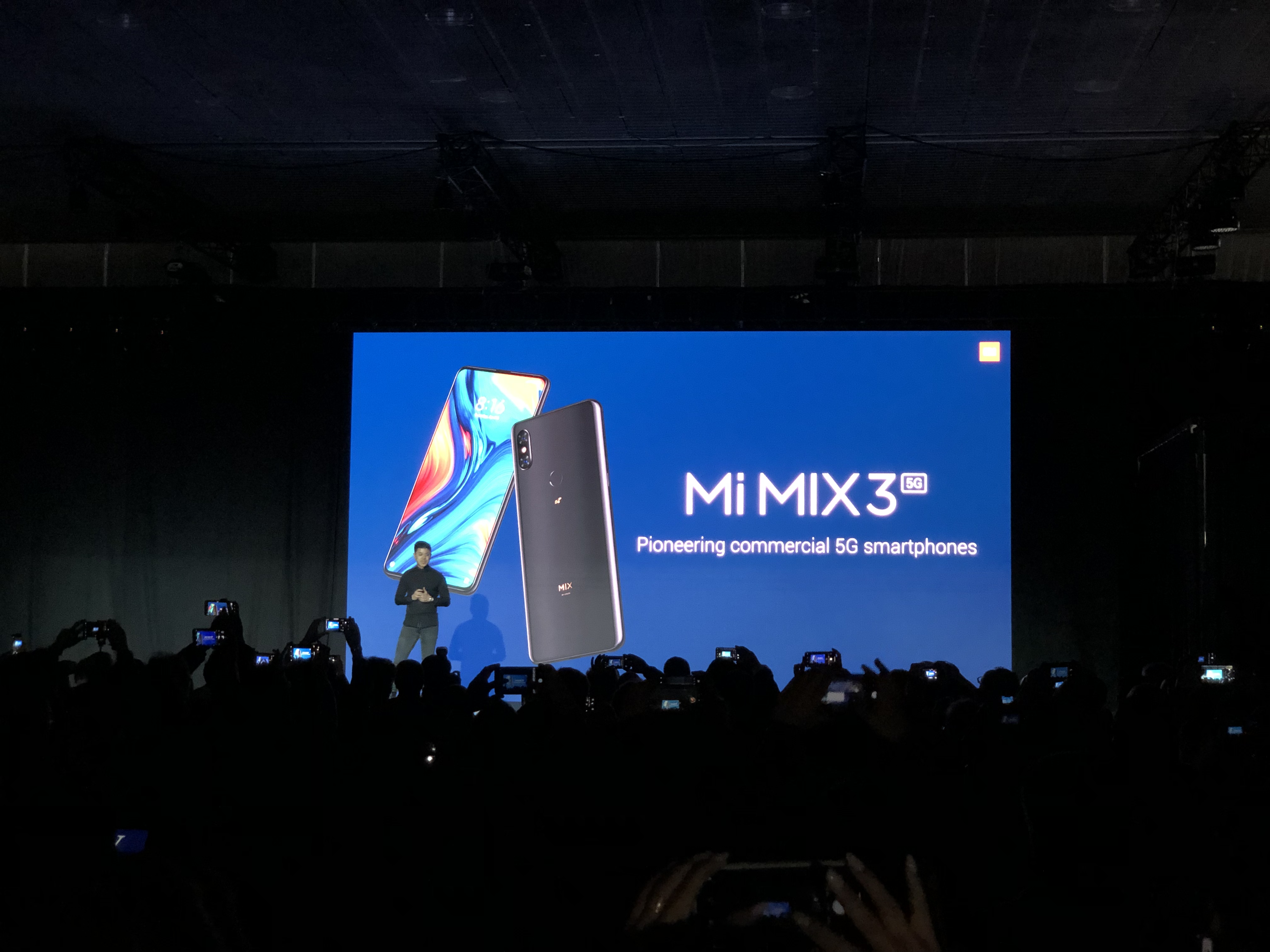
Chipmaker Qualcomm’s president, Cristiano Amon, stole a little of Xiaomi’s thunder by naming the Mi Mix 3 5G first during a turn on stage at the press conference as a Xiaomi partner.
Amon took the opportunity to give a muscular sales pitch for 5G, claiming the next-gen cellular tech would come faster than the transition from 3G to 4G/LTE and bring transformative benefits for consumers — touting the likes of premium gaming on mobile to replace game consoles. That’s because 5G should greatly lower latency and improve online gaming.
“5G is here. Not in 2020, not in late 2020 – it’s here right now in 2019. 2019 is the year of 5G,” he claimed, suggesting 5G device launches would be fast-followed by commercial 5G services as early as the second half of this year.
On device AI will also get a boost from 5G, Amon suggested, arguing that “every” app will be able to leverage machine learning thanks to reduced latency.
“You can unleash the power of the cloud for every app and service,” he said.
“5G will improve substantially how we think about our phones,” he added. “Everything will get better.”
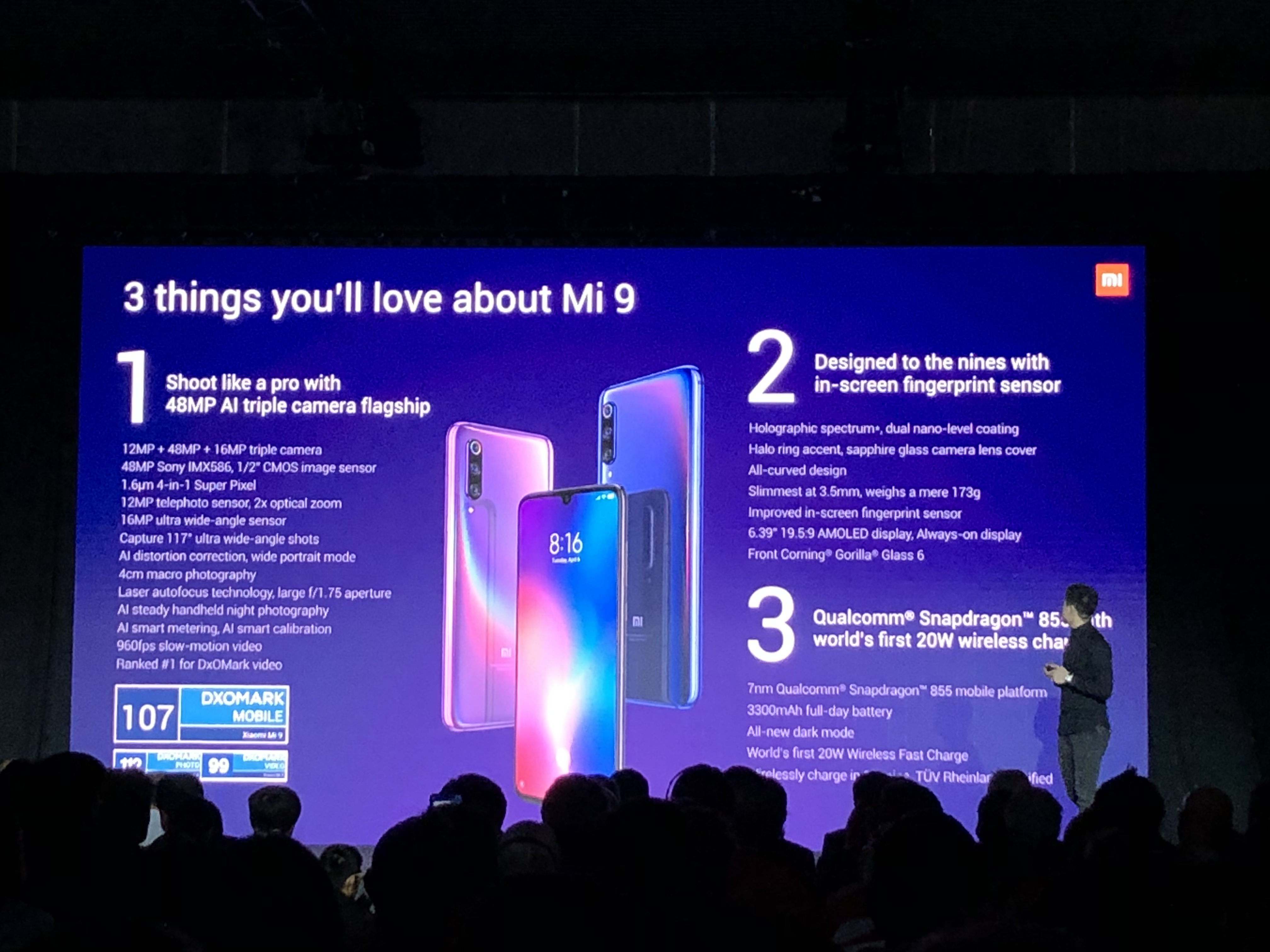
Xiaomi also used its first MWC new product launch event opportunity to announce the Mi 9 once again. The company has already unveiled its new flagship device earlier this week. It’s a more traditional phone with a waterdrop-shaped notch, a Snapdragon 855 chipset and a triple camera system. You can find a 48-megapixel camera, a 16-megapixel wide-angle camera and a 12-megapixel telephoto camera on the back of the device.
The Mi 9 will be priced at €449 ($510) for 6GB of RAM and 64GB of storage, €499 ($565) for 6GB of RAM and 128GB of storage. Pre-orders start from today in select European markets — devices should ship by February 28.
There are now 224 million monthly active Xiaomi smartphone users globally. While Xiaomi phones aren’t available in the U.S., you can now buy Xiaomi phones in Spain, the U.K., France and Italy in addition to many Asian markets.
Xiaomi also talked up its wider product portfolio, saying it has more than 2,000 Xiaomi-branded products in all, working with more than 200 partners. The company reiterated that it’s committed to having a dual strategy of smartphones plus A-IoT
It singled out electric scooters to say it’s shipped more than 560,000 Mi scooters to date. The Mi scooter was “probably the best selling personal transportation device in the world in 2018”, it added.
At the event it also announced the launch of another new product: The Mi LED Smart Bulb — a connected light bulb that lets users control light color and brightness via their phone. It’s priced at €19.90. The company tried to demo its smart home ecosystem but failed to turn off the air purifier using Google Assistant.
Xiaomi didn’t say a word on its foldable smartphone. It looks like there’s still some more work to do on the device.
